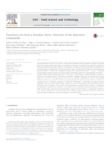Please use this identifier to cite or link to this item:
http://www.alice.cnptia.embrapa.br/alice/handle/doc/1066596| Title: | Functional tea from a Brazilian berry: overview of the bioactives compounds. |
| Authors: | SILVA, J. K. da  BATISTA, A. G.   CAZARIN, C. B. B.   DIONISIO, A. P.   BRITO, E. S. de   BIASOTO, A. C. T.   MARÓSTICA JUNIOR, M. R.   |
| Affiliation: | JULIANA KELLY DA SILVA, UNICAMP; ANGELA GIOVANA BATISTA, UNICAMP; CINTHIA BAÚ BETIM CAZARIN, UNICAMP; ANA PAULA DIONISIO, CNPAT; EDY SOUSA DE BRITO, CNPAT; ALINE TELLES BIASOTO MARQUES, CPATSA; MÁRIO ROBERTO MARÓSTICA JUNIOR, UNICAMP. |
| Date Issued: | 2017 |
| Citation: | LWT - Food Science and Technology, v. 76, p. 292-298, 2017. |
| Description: | The consumption of berries has become a trend with confirmed health properties; however, fruit peels have been wasted despite their high concentrations of bioactive compounds. Tea made from jaboticaba (Myrciaria jaboticaba) peel (JP) could be an alternative to make use of this byproduct and contribute to increased intake of polyphenols. For this reason, this study investigated the JP chemical omposition and bioactive profile, as well as the antioxidant capacity of its aqueous extract (JPT e 25 g L1). The peel corresponded to approximately 35% of fruit weight. Total fiber content was approximately 30 g 100 g1, and the soluble portion represented 8.50 ± 0.21 g 100 g1. JPT showed strong antioxidant capacity according to all methods tested (FRAP, DPPH, and ORAC). Phenolic, flavonoid, and anthocyanin content were 54.55 mg GAE, 8.33 mg catechin, and 4.34 mg cyanidin 3-glucoside in 100 mL, respectively. Phenolic content in a cup of JPT (250 mL) was approximately 150 mg GAE, which could be considered an important source of bioactives. Cyanidin-3-O-glucoside, delphinidin-3-O-glucoside, and ellagic acid were identified in JPT by LC-DAD-ESI/MS. Other polyphenols were investigated by PLC-DAD-FLD in the hydrolyzed extract, and gallic acid and rutin were the prevalent compounds after cyanidin-3-O-glucoside. The hydrolysis increased total phenolic, but not affected the antioxidant capacity according to DPPH e FRAP. The JPT color, anthocyanins and antioxidant capacity showed stability in refrigerated conditions, even without additives, for up to three days. These findings suggest that aqueous extract could be an adequate way to utilize the functional properties of jaboticaba peel. |
| Thesagro: | Chá Subproduto Bebida Myrtaceae |
| NAL Thesaurus: | Tea Phenolic compounds Byproducts Beverages |
| Keywords: | Chá funcional Baga brasileira Compostos fenólicos Jaboticaba |
| ISSN: | 0023-6438 |
| DOI: | 10.1016/j.lwt.2016.06.016 |
| Type of Material: | Artigo de periódico |
| Access: | openAccess |
| Appears in Collections: | Artigo em periódico indexado (CPATSA)  |
Files in This Item:
| File | Description | Size | Format | |
|---|---|---|---|---|
| Aline12017.pdf | 400,36 kB | Adobe PDF |  View/Open |









